 By Jon Durmin
By Jon Durmin
I’ve already argued at length that Namor, the Sub-Mariner, the Avenging Son shares parallels enough with the Last Son of Krypton to be described as Marvel’s Superman. Well since that little tract was such a hit, the powers that be at M6P (Jarid) have deigned to allow me to further posture on analogies we might draw between the mighty Marvel mythos and other fantastic figures. Thus we are one entry late in inaugurating a new (but probably not very regular) column written by yours truly: Analogies to Amaze! Since I began this work without realizing it in my essay about Marvel’s FIRST superhero, the Sub-Mariner it seems only appropriate that I follow that up by pontificating about his close second, Jim “The Human Torch” Hammond! What could be more Timely (pun intended true-believers), in the year of the 75th anniversary of Marvel Comics #1 than to let them lead the way? It is my hope that in the text to follow I will successfully draw connections between one of the so-called “Big Three” of the distinguished competition and the Torch as well as between some pretty prominent figures from classical literature, myth and folklore. A tall order to be sure, so we’d better stop all this posturing and get down to business.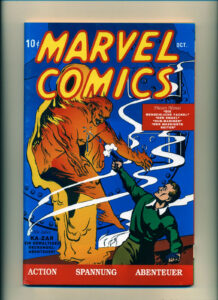
When the Human Torch debuted he was not the first figure to bear the title of superhero even in the newly rising medium of comic books. Notables like Superman & Batman had preceded him but unlike these contemporaries the Torch (along with Namor, the Sub-Mariner who joined him in Marvel Comics #1) was from the outset more rebel than role-model. In his classic history of Marvel Comics, Les Daniels points out that “while the Human Torch . . . [was a] grandiose figure, [he] spoke in slang and exhibited adolescent attitudes; often [he] accompanied [his] violence with corny wise cracks,” and that, “the danger of the Torch’s flame . . . gave [him] an extra edge”. Unlike Batman and Superman, less-so than even Namor, the Torch did not appear human when in his distinct flaming form. Despite his appearance as the athletic, blond-haired, blue-eyed and fair-skinned Jim Hammond he wasn’t human at all; rather a synthetic automaton constructed to resemble a man. While the content of his chronicled adventures would come to distinguish Jim Hammond as a hero, his non-human nature combine with the Torch’s rebellious attitude and dangerous edge to make him a fundamentally monstrous figure to the casual observer.

This monstrosity is exemplified in the retelling of the Torch’s origin from the perspective of photojournalist Phil Sheldon in the now classic Marvels by Kurt Busiek & Alex Ross. Sheldon attends the unveiling of Professor Phineas Horton’s artificial man and, like most of the journalists present, presumes the Torch to be a fake, “a mannequin doused in kerosene”. As the Torch begins to move inside his protective cylinder the reaction of the crowd advances first to shock, then outrage and declarations that the Torch is a danger to the city and must be destroyed. “It looked alive – as human as you or I – but it was on fire,” Sheldon recalls. Sheldon departs speechless and reflects on Horton & the Torch with pity as outcast individuals. Weeks pass and he forgets about the Torch until one evening while strolling through Brooklyn with his fiancé Sheldon hears a scream. Rushing for photographs he rounds the corner to see the Torch.
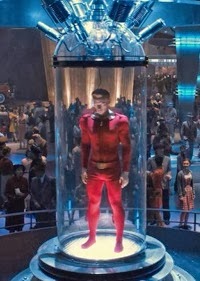
A monster is, by definition and convention, an entity that defies the boundaries of classification. The Torch is a figure whose class confounds the general scheme of the world. He appears to be a man, but he is on fire and flies. As a rule – men do not fly, and living men cannot be on fire without suffering harm, but the Torch moves like a living human. Phil Sheldon even recalls, “That – thing – it looked at me. Like a person would”. He identifies the Torch not as a person, but like a person. As the Human Torch’s very appearance of a living human on fire, is so contradictory to social structure he entered he lacks classification and thereby must be categorized as indefinable, as a monster.
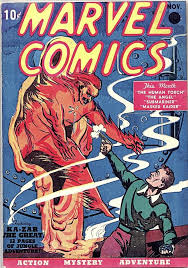
At the risk of being repetitive let’s return to the fact that the Human Torch is, in fact, not human at all. Rather he is an artificial man, an automaton designed to resemble humanity. In his exposition on the uncanny Freud recalls Jentsh citing that, “in telling a story, one of the most successful devices for creating uncanny effects is to leave the reader in uncertainty whether a particular figure in the story is a human being or an automaton, and to do it in such a way that his attention is not focused directly upon his uncertainty, so that he may not be led to go into the matter and clear it up immediately”. (Author’s note: I grandly appreciate the reader’s tolerance for my regression into scholarly pretense; I promise I’m almost done with the portion of this that I originally drafted as part of a legitimate scholarly paper . . . too many years ago.) The uncertainty generated by the Human Torch based on the ambiguity of his origins (was he born naturally or of artifice?) is evident in the reactions of those who witness the Torch at the moment of his unveiling by Horton and, later, at the time of his escape from his concrete prison. Returning to Phil Sheldon, he describes the expressions of his fellow spectators to the Torch’s revival, “those faces told a . . . story of fear and awe, and a world cut loose from its moorings”, but after the Torch leaves reactions change, “They couldn’t comprehend what they’d seen — so they dismissed it”. What Sheldon’s narration presents here is exactly the fear and disbelief that Freud notes as constituting a feeling of the uncanny.

An artificial being, designed to simulate a more perfect humanity. An inescapable association with the fire of life; met with apprehension and fear by the world he is born into. As clearly as these statements identify Jim Hammond they could just as easily be applied to one of the greatest figures of classical literature, the Monster of Mary Shelly’s Frankenstein. Frankenstein’s monster is perhaps the most famous of the literary figures to embody the Promethean myth. And here I go opening a whole other Pandora’s Box . . . literally. Y’see if one recalls the classical Greek myth of Prometheus it describes a Titan, Prometheus, who at the behest of the Gods of Olympus constructed humanity to worship and obey the newly ascended deities. As the legend goes Prometheus took pity on early humans, living in fear of cold and darkness and shared the fire of the gods, the spark of knowledge, soul, willfulness, insight, understanding rebellion and creativity. Those last two are especially important here and I’ll return to them in a moment, but first to finish our recall of the profoundly archetypal . . . Ahem, furious at Prometheus for letting the lowly mortals in on the key to their godly powers the Olympians chained him to Mount Kazbek in modern Georgia (no, the other Georgia). Eventually Hercules freed him but that’s a whole other story (and potential Marvel character for me to blather about).
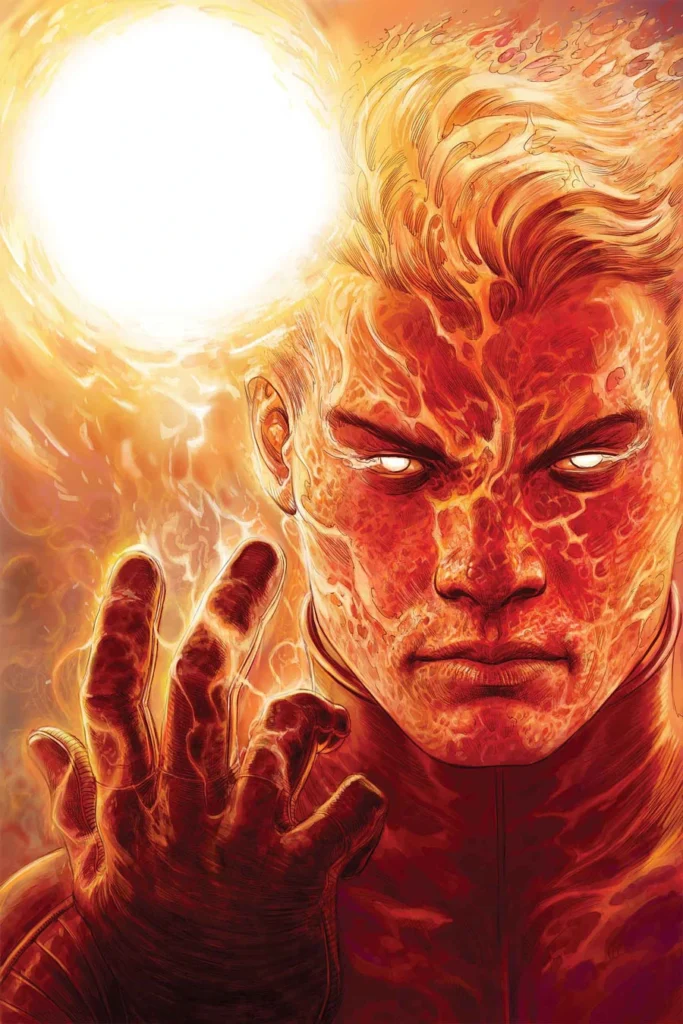
Back to early [Greek myth] humanity and their new found mental prowess borne of that first Olympian flame (a torch for humanity if you will). Almost immediately after receiving this second boon from their maker (Prometheus) humanity got wise that they could just burn the fatty outer skins of their animal sacrifices to the gods and eat the meat within. Well getting cut off from what they considered their fair take of the meat (i.e. 100%, and you thought your tax rate was bad!) sure ticked off Zeus and his court so they constructed a woman from clay, named her Pandora and, possessing a sealed box that she was instructed not to look in and an unrivaled sense of curiosity, sent her to marry Prometheus’ brother. Pandora, being irresistibly curious, peaked in the box and in doing so allowed all the evils of the world to escape and plague mankind, punishing humanity for trying to keep a little meat and giving the Olympians an intermediary (poor Pandora) to take the blame for all the evils.
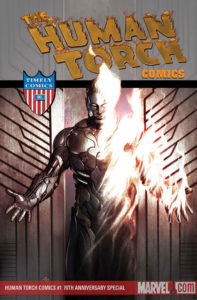
In the above pair of more ancient tales we’re treated to another story of creation and fire begetting monstrosity. Only here it wasn’t Phineas Horton fabricating the Human Torch, but Prometheus fabricating humanity. It was not the burning flame of the Torch that affected a perception of class defying monstrosity by humanity, but intelligence granted to humanity by the fire of Olympus that made man become monstrous and unclean in the eyes of the Olympian gods. Likewise, returning to Frankenstein, Victor Frankenstein is the creator, the Monster (sometimes called Adam) his creation, assembled from artificial flesh and matter, given life after exposure to lightening. I would be remiss if I didn’t note that lightning has been described poetically as ‘fire from heaven’ and was, in the Greek mythos, sole property of the godly chieftain Zeus. It certainly isn’t without cause that Mary Shelly’s most noted work is fully titled Frankenstein: The Modern Prometheus. And like Prometheus, Frankenstein is punished for his transgression in generating a monster to replace humanity. Actually, Phineas Horton gets of pretty easy here as a contemporary of Prometheus and Frankenstein; those guys got chained to a mountain and hounded to the ends of the Earth respectively while Horton just got forced into early retirement.

One can go back further than the era of Victorian literature to find more repetition on this theme. Just look at Pinocchio. Or better yet, return to the ancient Greeks and the myth of Pygmalion. Pygmalion had a low opinion of the women on his home island of Cyprus so he sculpted himself an idealized woman from marble. Feeling lonely Pygmalion prayed to the love goddess Aphrodite for a real woman as perfect as his idealized statue and upon returning home discovered that the statue had been given life. Of course in the long form of the story (for example George Bernard Shaw tale/play of the same name set back again in Victorian England, or the 20th century musical adaptation of Shaw’s work, My Fair Lady though the happy ending tacked onto the latter version rather misses the point) that spark of life, that fire of intelligence that makes the facsimile more than a mere statue ultimately ends up leading Galatea (Pygmalion’s statue) to grow beyond the needs and wishes of her creator, driven by newly sparked intellect and it’s companion curiosity to a state of challenging Pygmalion that makes her less perfect in her creator’s eyes. Again, we have a creator (Pygmalion) whose creation (Galatea) is deemed monstrous after contact with celestial fire (the blessing or enchantment of Aphrodite).

I diverted this discussion all the way to the realms of classical literature and mythology as a detour back to the realm of modern superheroes largely because the analogous relationship I am about to draw between the Human Torch and another character is, I believe, better appreciated in light of this additional information. I’ve been discussing Olympian lore for four paragraphs now and I feel I’ve finally created the proper tone to introduce the final key figure of our amazing analogy, one of the Distinguished Competition’s big three, Wonder Woman. If we consider Diana of Themyscira as on the basis of her powerset and appearance alone, as a powerful woman, Thundra, Valkyrie, the Squadron Supreme’s Power Princess, or perhaps even She Hulk might be readily trotted out as examples. If seeking a Marvel analogue for her based on her status as DC’s most recognizable female intellectual property we may be tempted to compare her to Storm (or Carol “Captain Marvel” Danvers, or Black Widow, or Spider-Woman, or Susan Storm depending on what era of comics we’re asking the question about). If we look beyond such superficial criteria to her inherent qualities and origins, as well as her primacy as a recognizable figure from the Golden Age, these other comparisons are shown to lack substance and the Torch ascends to be Wonder Woman’s 616 corollary.
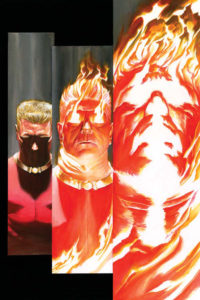
Diana’s origin has generally been (at least until the New 52, but, ugh) a repetition of the Promethean tale. Her mother (creator) Hippolyta, ruler of the lost Amazonian kingdom of Themyscira, longed for a daughter untainted by the involvement of a man in her conception, and so she crafted a perfect daughter from the clay on the shores of her island of womanhood. Hippolyta then prayed to the Olympian gods (them again) and the goddesses of that pantheon as well as the male god Hermes (god of messengers, language, learning and magic) bestowed their blessings on the clay figure (A spark of life/intelligence/fire from Olympus). Eventually Diana’s curiosity drives her to leave Themyscira for the outside world of men. This is an act of rebellion violating the Amazonian taboo of isolation as well as their prohibition against interacting with men. Diana, willing to transgress these rules of order in her society, violates the rules of classification the Amazons set for themselves becoming monstrous (in principal) to them. (Yet another Author’s note: It also bears consideration that Hermes’ blessing to Diana may already have violated the male-less definition of perfection that Hippolyta sought for her perfection.) Simultaneously, to those in “Man’s World” Diana is a singular being, her amazon heritage and unique, divinely bestowed gifts denying her recognition as a “normal” human woman. Here we have another figure, like Jim Hammond, who is an automaton crafted from inorganic material to simulate a presentation of humanity meeting the definition of perfection as set by her creator who becomes monstrous by virtue of the fire associated with her creation.

The parallel doesn’t end there, but that core Promethean-archetype is one that is inherent to the Torch and Wonder Woman that is not shared by many other characters from either publisher. To pursue their corollaries further the common response of Jim Hammond and (the original) Princess Diana to the new worlds they enter is notable. Both choose careers in pursuit of law, order and justice. Wonder Woman seeks close ties with and sanction by the United States government while the Torch joined the NYPD in his Golden Age adventures and more recently becoming the virtual conscience of the agency S.H.I.E.L.D. They both leave vigilantism behind to become the rare superhero to actively work as an agent of those in authority of their own volition. They also both become key figures in battling for democratic ideals against tyranny, Wonder Woman being an iconic opponent of totalitarianism and female exploitation while in his universe the Human Torch became a major challenger to the despotic axis of fascism to the point of having the profound distinction of executing Adolf Hitler at the close of the war in Europe. Neither of them operates behind a mask.

These actions and choices held in common by Jim and Diana are indicative of something deeper; a desire not to simply help or protect the world around them, but to serve as an example to others. An example of good citizenship, civic virtue and engagement with the world. An example of how to serve the common good and protect society without breaking its rules. Batman, Spider-Man, Daredevil, the Lone Ranger and so many other so-called crime-fighters seek justice from behind a mask. The use of a mask serves as a declaration of willful choice to set them outside the communities they claim to serve. They claim to fight crime yet their vigilantism is an act of criminality. They transgress against society willfully even as they claim to be proponents of its welfare. By contrast, the Human Torch and Wonder Woman know what it is to be perceived as outsiders, as monsters by those around them. The nature of their very existence violates the rules of the worlds they were brought into and in response they choose to seek acceptance by actively conforming to and protecting the order of that world as best they are able.
Even from a publishing perspective dating back to the golden age of comic books Wonder Woman has been recognized as one of DC’s so-called Big Three, broadly recognizable marquee characters. Likewise, the Human Torch was (with Namor & Captain America) one of Marvel’s Big Three back in the Golden Age and there’s no reason he shouldn’t recapture some of the visibility he once had. After all, in every way save gender representation (which IS important, but Marvel has other ladies who are great in a different way than Wondy) the Human Torch represents the same themes and ideals that Wonder Woman does. Luckily we don’t need to raise a call to Marvel to see the Torch be back to his proper stature. James Robinson has been doing that work for us, one careful step at a time, in his increasingly engaging and exciting work as the present author of Fantastic Four and All-New Invaders. So go check out these terrific titles 616-ers and see why Jim Hammond really deserves to stand at the fore of Marveldom as his cognate at the competition does for her Delightful Cohort.

(Seriously, go buy All-New Invaders it’s very good and the last page of the first story-arc will knock your socks off.)


